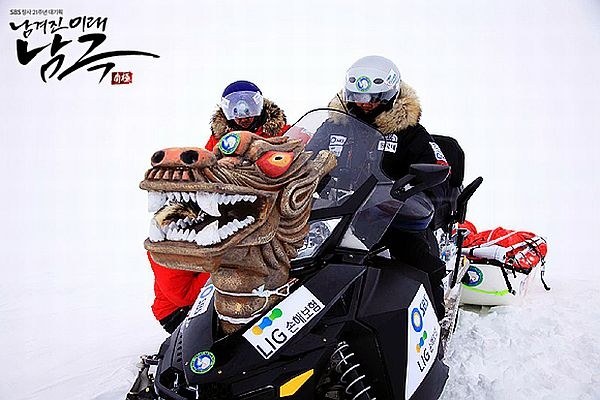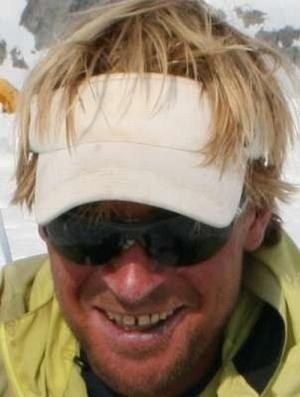All news: 27 January 2011
New records of Antarctica
South Pole.
British team sets new speed record for Antarctic crossing. In late November, a group of British adventurers and scientists set off on a mission to the interior of the Antarctic continent in specially designed research vehicles. Their plan ...
British team sets new speed record for Antarctic crossing. In late November, a group of British adventurers and scientists set off on a mission to the interior of the Antarctic continent in specially designed research vehicles. Their plan was to undertake several environmental research experiments while journeying through one of the most in hospitable environments on the planet, but they also managed to set a new speed record for an Antarctic crossing at the same time.
Dubbed the Moon-Regan Transantarctic Expedition in favor of its two organizers, Andrew Moon and Andrew Regan, the plan was for the team to conduct research along the way. For example, they collected samples of the Antarctic snow in order to test the impact of pollutants in the atmosphere of the Southern Hemisphere on the frozen continent itself. They also drove a specially designed snow buggy, powered by biofuels, in order to see how those experimental fuels performed in extreme conditions.
By all accounts, those research elements came off very well, but the real success of the mission was the speed crossing. It took the team just 13 days to drive from the Union Glacier Base to the Ross Ice Shelf, by way of the South Pole, on the far side of the continent. The expedition covered 1209 miles in 303 hours, using specially designed ground penetrating radar to help them avoid crevasses and other obstacles.
The expediton actually reached their destination back on December 9th, but then turned around and made the return trip so that the 10-man team, along with all their research vehicles and gear, could be plucked from the ice by Antarctic-Logistics and Expeditions, a company that specializes in delivering explorers to Antarctica. That happened last week, when the team was returned to Punta Arenas, Chile before making their way back home in time for the holidays.
Taking just 13 days to cross Antarctica is quite an impressive feat. While the team did indeed use motorized vehicles to do it, the terrain that they crossed is quite brutal on any kind of machine and the cold weather played havoc with their engines at times. Throw in the very real danger of driving into a crevasse, and you can start to appreciate the challenges of such a drive. This just might have been the most challenging road trip ever.
*******
Weather blocks expedition team from crossing Antarctica
A Cloudy Antarctica Stymies Solar Snowmobile Trek
A Korean expedition team looking to trek across Antarctica using solar-powered snowmobiles has run into trouble as unseasonably humid weather leaves the usually sunny and clear summer skies overcast and dull.
The expedition, led by veteran mountaineer Park Young-seok, set off from Antarctica’s Patriot Hill in late December on a 1,056km journey to the South Pole, but the from the beginning the team has been beset by difficulties, not least of which is heavy cloud cover – part of the massive storm system causing record rainfall on the Australian mainland – which dumped more snow than the region has seen in 20 years.
The initial idea was to utilise Antarctica’s "endless summer," in which the sun never fully sets from November through until February, a major bonus when running heavy machinery with solar power. But the team’s best laid plans played second fiddle to the weather gods and Antarctica’s white night never eventuated, leaving the team 330km from their destination. Unless they can reach the South Pole by Sunday, they will have to abandon solar-powered sledding and fill their snowmobiles with gasoline to make it back to base camp.
This solar energy-blocking cloud greatly impacted the portable solar recharging equipment for the team's eco-friendly snowmobiles and other camp equipment for much of the time. The solar recharging stations use high-efficiency SunPower solar panels. In full sun they can provide enough power for a three hour drive from a nine hour charge.
Park’s expedition will be made into a documentary for the Seoul Broadcasting System as part of its 21st anniversary year celebrations. They hope the trip will raise the profile of solar energy use in Korea and around the world.--
*******
Norwegian breaks South Pole record
Christian Eide, a 35-year-old expedition leader from Oslo, was still relishing his record-breaking solo trek to the South Pole over the weekend. He arrived at his goal last Thursday, just 24 days, one hour and 13 minutes after leaving Hercules Inlet on December 20, 1,150 kilometers away from his goal.
Oslo expedition leader Christian Eide, after breaking a world record skiing to the South Pole.
His solo world record soundly beat that set by American Todd Carmichael, who used 39 days and seven hours. Eide said he was so excited as he neared his destination that he couldn’t manage to sleep on the last night. He had expected to spend 30 days skiing to the South Pole, so surprised himself with his own speed.
“I just had to keep going,” said Eide, who runs an Oslo-based expedition company called L’atitude. He arrived on Thursday January 13, after skiing alone for three-and-a-half weeks. He average around 47 kilometers a day, but skied around 90 on the last day.
He wrote in his firm’s online diary, though, that he didn’t get a very warm welcome from the Americans running the Scott-Amundsen base. ”I got a strict message that I wasn’t allowed to go inside the base to get my sheet of paper with my official arrival time,” he wrote. “The Americans have decided to have a strict policy towards ‘tourists.’ Is it really necessary to be so unwelcoming? The Americans are otherwise usually very nice.”
On Sunday he was resting after a flight back at the ALE base (Antarctic Logistics & Expeditions LLC) on Union Glacier, where he described spring-like conditions with temperatures as high as minus-7C and sunshine, compared to minus-32 at the South Pole. Around 70 persons were at the base camp, waiting for flights back to Punta Arenas or for new arrivals, and the mood was festive.
Eide wrote that the wait was “perfect” for him, giving him a chance “to relax, calm down, rehash the tour and the result.” He admitted he could still feel the effects of the strenuous tour, and he had some frost and sun damage on his nose.
--













